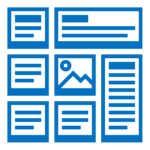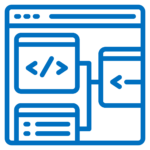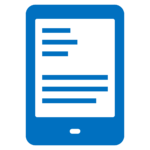
When considering how to produce accessible content it is vital that all areas of the publishing ecosystem are taken into consideration as they all have a role to fulfil. Every publishing organisation works slightly differently so we cannot advise on a definitive method of assigning tasks, but this page endeavours to give you pointers as to how you can make sure that you have all areas covered and should give you an appreciation of the essential nature of the roles within a publishing workflow to ensure accessibility.
Internal accessibility lead

The internal accessibility lead can be an individual or a group of people who are responsible for ensuring that all departments and individuals within an organisation collaborate to work towards the goal of producing accessible content. A thorough understanding of the issues surrounding accessibility is needed, alongside a real passion to see through the necessary changes within your organisation on behalf of the print disabled community.
Roles usually assigned to this person / team include:
- Policy setting and implementation
- Communicating and raising awareness of accessibility issues
- Stakeholder management and coordination
- Advocacy with senior management for budget issues
- An understanding of the legal requirements surrounding the specific type of content being produced by the organisation
- Being the contact person for all accessibility-related issues
Useful links in this website: business case, charter, and resources.
Senior management

Whilst members of the senior management may not get involved in the detail of content production it is vital that they show their support and commitment for accessibility issues. Support for an accessibility policy and for the internal accessibility lead shows the rest of the organisation that this is an important issue which they should be taking seriously. Taking the time to understand the benefits that are on offer and to advocate for the business case is a major hurdle that you can help to overcome.
Useful links in this website: business case, charter, and resources.
Author

Authors can help print disabled readers by creating content which does not assume a fully sighted reader. Ensuring everything in the book is described with language, rather than just images, can be a good start. But even where images are essential, discussing the provision of image descriptions with your publisher can radically enhance the accessibility of your title.
Creating accessible content in this way carries other benefits for you as an author. Ensuring full semantic richness means your book can have a life beyond the printed page, making it more future-proof and adaptable. You may even find yourself needing to do fewer rewrites for new formats as a result, as well as widening your readership to the huge market of print disabled readers and consumers of audio content.
Editorial

Editorial colleagues should have a good understanding of accessibility and how it affects each step of the process, from ideas and commissioning, through development, desk editorial, cover design and images.
Almost any decision in the planning and production of a book can be made with accessibility in mind, so editors should be considering this from the beginning and including it in their plans and conversations with colleagues, authors and suppliers. Anything from format, paper colour, page layout and design choices, careful use of language, through to highly deliberate and conscientious use of images (and procurement of descriptions for them where possible) can make the book more accessible to the end reader.
Editorial staff are vital facilitators in the chain of accessibility that ultimately leads to books reaching the widest possible range of audiences.
Design

There are a range of choices that designers can make to ensure the books they work on are as accessible as possible. Indeed, the designer is a vital bridge between content and reader, and designers should bear in mind that many readers are partially-sighted and as such heavily disadvantaged by some design choices.For instance, considerations around colour and minimum contrast ratios (especially in text), use of colour coding to convey and distinguish information, certain fonts, and unusual/non-encoded characters can all present issues.
There is plenty of good information about accessible design choices around the web, but we recommend starting with the WebAIM introductory piece on colour contrast.
Production

The production process is instrumental in bringing together all of the information and techniques required to create and publish a truly accessible book. Tasked with managing the delivery of the printed book or digital ebook, production is very often the department that oversees the progress of a title both in-house and when using external suppliers, and this could very well include making sure that all the other departments have completed their tasks.
The Production team (and/or a dedicated ebook production team) is usually responsible for outsourcing work with suppliers, and thus the onus is on them to ensure that these third party vendors fulfil their roles in the chain that brings accessible content to market. Vendors can include, but are not limited to:
- Alt text providers
- SMEs
- Conversion houses (including the conversion of mathematical content at scale)
- Typesetters who produce EPUB alongside print files
- Ebook developers – for both reflowable and fixed layout content
Production may also be the department responsible for quality control and archiving of materials – both crucial areas for the maintenance of accessible content.
Website and platform design

Website design and maintenance can fall under several different departments: Marketing might be responsible for products and news sections, while IT might oversee ecommerce functionality and Publicity upload events. Publishing websites should comply with current WCAG standards, which means that anyone working on a site and uploading content should be aware of these accessibility requirements. For example, images should have associated alt text, and typefaces, colours and design features should be easy to read and navigate. The W3C have created a useful guide to how the WCAG standards apply to different roles.
Some publishers also produce and host interactive elearning platforms. Learning resources must be usable by all customers irrespective of ability, so accessibility should be considered in every aspect of design, content and function. Additional considerations for platforms include accessible multimedia and downloads (pdfs, audio, worksheets), ensuring that interactive elements are easy-to-use and work well with assistive technologies. To ensure that platforms are fully accessible, appropriate user testing should be factored into the design stages and every time a new feature is rolled out.
As well as complying with accessibility standards, websites and platforms should include accessibility statements to ensure that customers understand what the company has to offer, how accessible their products are, and who they can contact for more information. Good examples of accessibility statements can be found on on the Kogan Page website as well as the Taylor & Francis site
Advice on how to produce an accessibility statement and the information that should be included can be found on the ASPIRE website. The ASPIRE project also assesses accessibility statements, and a list of publishers and platforms and their current rank can be found on their website.
Sales and marketing

The sales and marketing departments manage crucial relationships within the publishing process and their understanding of the accessibility of their products and platforms is crucial. Sales teams must be very clear about what level of accessibility their content offers.
Marketing copy and presentation materials should be written with accessibility in mind (not to be confused with “access”), both in terms of language and layout. Ensuring that company announcements, retailer presentations and website copy are all fully accessible to the end-user will ensure maximum engagement with consumers of all abilities. The Inklusion Guide is a free online resource that provides best-practice accessibility advice for anyone running hybrid, online or in-person literary events.
Metadata sent out in feeds can also include accessibility information about digital products. Onix codes can indicate to retailers and consumers if an EPUB file includes navigation functionality and/or Alt Text, for example, increasing the discoverability of a product and increasing the potential market.
Customer facing roles
Customer service

It’s crucial to have a clear point of contact for dealing with accessibility enquiries. Clarity of responsibility will ensure that this person has the necessary skills and knowledge to enable an efficient and reliable service for readers.
It should be straightforward for customers to find contact details, clearly displayed alongside the organisation’s accessibility policy. Enquiries should be handled in a timely manner so that readers are not having to wait to access content.
Ideally this person should be able to discuss exactly what accessibility means for a specific customer in order to be able to facilitate access promptly and efficiently – an understanding of the various formats is extremely useful here together with liaison with the internal accessibility advocate who will be able to direct questions.
To summarise – a clear process for dealing with customer enquiries is vital so that readers can be helped and directed to solutions in both a timely and professional manner.
Distribution & retail experience

As part of the ecosystem, the distribution and retail systems must be accessible to all readers. You may have a born accessible title which your readers cannot access due to poor search, opening and downloading facilities. Platforms need to be able to work efficiently with assistive technology to enable swift and suitable access.
Whether you are using a third party platform or whether you have your own content distribution channel, you need to make sure that it conforms to the guidelines set out by WCAG. Examples of excellent progress in this area is being made by VitalSource and RedShelf.
Reading apps

Reading apps, together with the devices they are used on, need to be tested for accessibility so that the reader is using the correct combination to suit their particular access requirements. Many reading system organisations are working on the accessibility of their apps and are making improvements all the time to increase the accessibility support they offer. Many developers collaborate with the EPUBTest initiative which tests the accessibility of their reading system. These results are publicly available via epubtest.org and the shorter overview version on Inclusive Publishing.